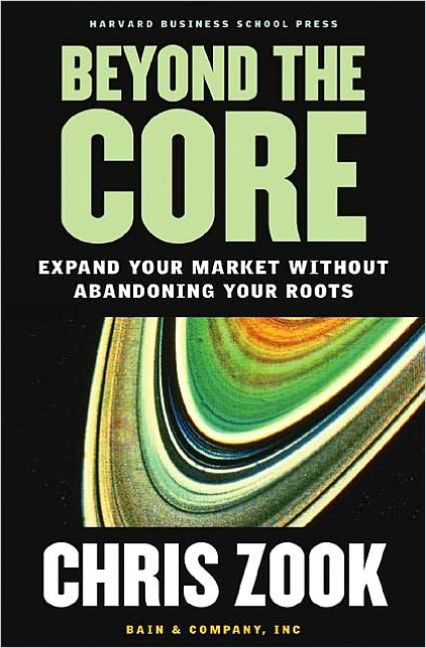Corporate growth strategy expert Chris Zook explains why you should focus your expansion efforts on “adjacencies” closely aligned with your core business.

Adjacency Strategies
Author Christ Zook, partner and co-head of a major consultancy’s global strategy practice, bases his observations and recommendations on extensive research: He profiles 25 corporate growth leaders, reviews 181 corporate growth initiatives, and covers a trio of in-depth surveys of executive attitudes and insights on growth. He analyzes 12 pairs of companies that were comparable in the 1990s but are no longer in the same league since some firms have outpaced their match in growth and profits.
Finding or maintaining a source of sustainable and profitable growth has become the number one concern of most CEOs.Chris Zook
Zook is also the author of Profit from the Core and Unstoppable, which – with Beyond the Core – form a solid trilogy of smart books on business growth. Just remember that this business classic dates from 2004, so his reported outcomes have changed, but his strategies endure.
Growth Through Adjacency
Zook makes numerous recommendations on how to achieve sustainable growth through adjacency expansion. He also cautions against ill-advised M&A, poorly planned product introductions, and unwise market expansions. Sometimes saying no is the smartest move.
Companies find sustaining profitable growth increasingly difficult. Only 13% of the 1,870 companies in one 10-year study achieved even minimal profitable growth. Yet, leaders have unlimited ways to build their firms, including diversifying, investing venture capital, developing new markets, creating new offerings, building up their core business, globalizing, and improving productivity.
While research indicates that adjacency strategies – while they carry more risk than organic growth – are the best way to expand, Zook says you must work only with firms that share your size and nature, have a close relationship with your core business, and can “push the boundaries.” The author warns that many business leaders fail to understand the substantial risks associated with even small adjacency moves.
Pushing out the boundaries of a core business is one of the most difficult management challenges.Chris Zook
However, he believes such strategies have three main benefits: they build profitable new growth, make the core business stronger and help companies reorient to meet new market pressures.
As of 2004, UPS demonstrated profitable growth through adjacency. Beginning in 1907 with bike messengers, it began delivering packages by 1918. It expanded regionally by 1950 and nationally – with two-day service – three years later. In 1988, UPS purchased a fleet of planes, which enabled next-day service. Today, it delivers worldwide.
The Li & Fung company used adjacencies to strengthen its core business. It began exporting fabric, jade, porcelain, ivory and fireworks from China in 1906. In 1937, it moved to Hong Kong and added more goods. By the 1970s, exporting finished goods could no longer sustain it. Building on its “detailed knowledge of Asian manufacturing, its network of local offices, and its ability to move goods,” Li & Fung moved into managing outsourcing for Western garment manufacturers.
Lloyds Bank reoriented to meet market needs. Founded in 1765, it became one of the UK’s “Big Four” commercial banks by the 1980s, though its profitability dropped well below the others. CEO Sir Brian Pitman turned it around by extricating it from poorly performing expansions and centralizing control of local branches, which became mortgage and insurance retailers. Finally, Lloyds began acquiring other banking networks and replicating its adjacency strategies.
How Adjacency Works
Adjacency expansions usually fit one of six categories: product adjacency through selling new services and products to current customers; geographic adjacency by moving into new territory; value chain adjacency through new offerings; channel adjacencies via new markets or distribution conduits; customer adjacencies by selling current offerings to new customers; and new business adjacencies by promoting a current capability into a new business.
Our intention was to find even small parts of key customer segments where we could become number one in the world.Pasquale Pistorio, CEO, STMicroelectronics
Zook explains that a strong business with a robust core can make 80 to 110 different adjacency moves at any given moment. The trick is deciding which ones will work, and when and how. He counsels applying three simple yet rigorous criteria to your adjacency partners: true adjacency to “a strong business core,” an opening to become a market leader, and strong profits.
Still, adjacency carries risk. Only one in four adjacency expansions creates true value and meaningful growth. Between 1997 and 2002, 75% of the 25 most publicized, non-web-related stock devaluations involved failed adjacencies. Despite the risks, however, such moves are vital to maintaining a company’s price since investors’ expectations of adjacency expansions account for almost 50% of most stocks’ value.
The management team that applies rigor, not a vague sense of creativity or gut instinct, wins the long-term adjacency game.Chris Zook
Adjacency also claims notable successes, such as American Airlines, which used its Sabre reservation system to develop a new commercial service. Zook also cites Vodafone, which expanded geographically through acquisitions and became a global cellphone leader, and IBM Global Services, which used adjacencies to make the transition from failing products to new services.
The Lesson of STMicroelectronics
In 1980, Italy’s SGS Group (the predecessor of STMicroelectronics), a small computer hardware company, was losing money; its competitors were beating it to death. Then, under new CEO, Pasquale Pistorio, the company eliminated 80% of its unprofitable product lines. It concentrated on its core strengths, including “erasable programmable read-only memory” (EPROM), video compression, power management, and flash memory, and became Nokia’s leading supplier. In a series of good adjacency moves, it developed new computer peripherals, including disk drives, monitors and printers, and new consumer offerings. By 2000, the renamed STMicroelectronics was worth $6.3 billion as a world leader in microprocessing with $429 million in annual profits. It focused first on its profitable core business and then built outward from that base.
New waves of growth beyond the core can sometimes be found by looking deep within the core.Chris Zook
Zook demonstrates that STMicroelectronics used three important adjacency strategies: First, it expanded outward from a robust core in areas closely related to its central business. Second, it repeated its previously successful formula. Developing such an “adjacency machine” can give you a replicable pattern, increase your practical expertise, reduce your learning curve, minimize complexity, add clarity, and lead to quicker success. Third, it turned to existing customers to maximize its best growth opportunities. This requires deep knowledge of your customers. “Share-of-wallet” adjacencies – selling to customers whom you know well – are the most successful adjacency moves because they meet customers’ needs.
The Nike Story
Nike started in 1963 selling running shoes. In 1985, it contracted with basketball superstar Michael Jordan, whose endorsement activities made Nike a major player in basketball. In 1986, it worked with tennis star John McEnroe to move into tennis. During the 1990s, Nike ventured into hiking, cycling, soccer, football, baseball, and volleyball. In 1996, it signed a $100 million contract with golfer Tiger Woods, moving into golf apparel and gear. A newcomer in this highly competitive market, Nike captured 6% of sales when Woods switched from Titleist to Nike golf balls. As Nike became more prominent in golf, it contracted with additional tour professionals.
The massive, singular move and the leap to a totally new business are spectacular when they succeed, but they rarely do.Chris Zook
Nike made all the right moves in adjacencies. It employs a masterful, repeatable formula, and it never forgets that its core business is selling shoes. Indeed, its global market share in this category grew from 22% in 1990 to 38% in 2002. Nike’s dominance in adjacency strengthened its core business. Its adjacency machine succeeds over and over because of its in-depth knowledge of its customers.
Before You Commit
Zook says to ask three enduring questions before making an adjacency move: First, do the adjacency and the core business share a common infrastructure and customers? Second, who will make decisions affecting both the core and the adjacency, and how? Third, do the core firm and the adjacency partner have compatible corporate cultures? Many adjacency moves fail when they do not.
Psychological Pitfalls
Companies develop financial and psychological investments in their adjacency moves, which are problematic if an adjacency fails to make sufficient returns in a reasonable time. You may be tempted to prop up the losing venture to keep it going. This is almost always a mistake. It drains resources you could be spending on a winning venture. Cutting your losses can be painful, but necessary.
Companies that outgrow their core competitors for extended periods often do so because they have more success at moving into new adjacencies around the core.
An adroit, carefully planned, professionally executed adjacency strategy can enable your company to earn new profits and build value. But don’t venture too far afield. Zook’s core advice in this compendium of detailed guidance for leaders who must assess growth proposals – is that an adjacency must be truly adjacent.






